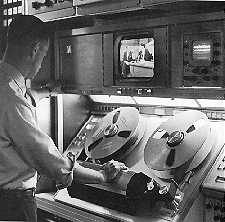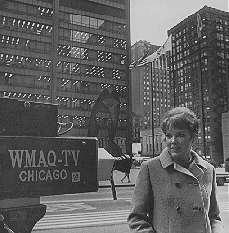After the color conversion
at WMAQ-TV, the next major technical advance was the arrival of videotape. This
device, which electronically records both image and sound on a two-inch wide strip
of acetate tape, began on an experimental basis in I956. WMAQ-TV hegan installation
of its first machines in early 1959. Today the station has eight videotape recorders.
| Right:
Video tape, making possible instantaneous recording and playback of program material,
is one of the most recent technical developments at channel 5. |
 |
In 1966, WMAQ-TV engineers
developed the nation's first small mobile videotape unit. On February 6, 1966,
the unit was successfully tested in nine-degree weather in Evanston. Now, with
a miniaturized color camera, it is part of Channel 5's daily news coverage. And
like so many other of today's highly technical and complicated pieces of equipment,
it has a nickname: VTMU (pronounced 'vit-moo').
 |
Left: WMAQ-TV's
video tape mobile unit facilitates on-location news coverage, as demonstrated
here by reporter Jorie Lueloff. |
WMAQ-TV studio facilities
have gone through a constant program of modification and improvement. The original
TV studio 'A' has been renovated twice. Channel 5 now has five all-color TV studios,
ranging from the 15-by-20 foot studio 'B' to the 45-by-71 foot studio 'A'.
| Right:
The control room of Studio D, WMAQ-TV's newest and most advanced production center,
is a highly sophisticated and versatile electronic marvel manned by skilled technicians
(and by director Roger Lee
Miller, the back of whose head is featured at the left). |
 |
The newest---studio
'D', a little smaller than 'A', was completed in 1967. It is the newest and most
modern facility of its kind in Chicago, and is fully equipped for the production
of either live or videotaped programming---in color and for the complete production
of color videotape commercials. It has a separate sound control booth, and a control
console whose limitations Channel 5's engineers have not yet found. One of them
summed up its abilities in just three words: ''It does everything!"
Late in 1969,
WMAQ-TV will move its transmitter from the 42-story Kemper Building to the new
100-story John Hancock Center. The new tower will improve still further the station's
reception.
|